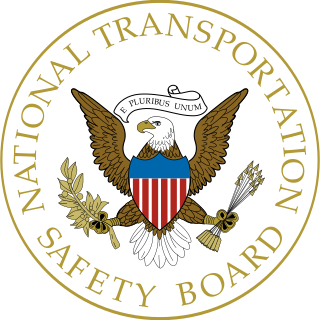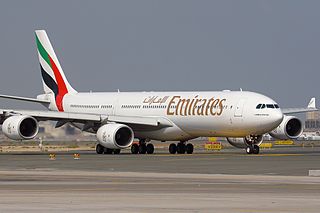In aviation, a SAFO (Safety Alert for Operators) is an information tool that alerts, educates, and makes recommendations to the aviation community .

The National Transportation Safety Board (NTSB) is an independent U.S. government investigative agency responsible for civil transportation accident investigation. In this role, the NTSB investigates and reports on aviation accidents and incidents, certain types of highway crashes, ship and marine accidents, pipeline incidents, bridge failures, and railroad accidents. The NTSB is also in charge of investigating cases of hazardous materials releases that occur during transportation. The agency is based in Washington, D.C. It has four regional offices, located in Anchorage, Alaska; Denver, Colorado; Ashburn, Virginia; and Seattle, Washington. The agency also operated a national training center at its Ashburn facility.
Mayday is an emergency procedure word used internationally as a distress signal in voice-procedure radio communications.

An aviation accident is an event during aircraft operation that causes serious injury, death, or destruction. An aviation incident is any operating event that compromises safety but does not progress to an aviation accident. Preventing accidents and incidents is the main goal of aviation safety.
A distress signal, also known as a distress call, is an internationally recognized means for obtaining help. Distress signals are communicated by transmitting radio signals, displaying a visually observable item or illumination, or making a sound audible from a distance.

An engine-indicating and crew-alerting system (EICAS) is an integrated system used in modern aircraft to provide aircraft flight crew with instrumentation and crew annunciations for aircraft engines and other systems. On EICAS equipped aircraft the "recommended remedial action" is called a checklist.

In aviation, a flight information region (FIR) is a specified region of airspace in which a flight information service and an alerting service (ALRS) are provided. The International Civil Aviation Organization (ICAO) delegates which country is responsible for the operational control of a given FIR. FIRs are the largest regular division of airspace in use in the world today, and have existed at least since 1947.

The Airports Authority of India (AAI) is a statutory body under the ownership of the Ministry of Civil Aviation, Government of India. It is responsible for creating, upgrading, maintaining, and managing civil aviation infrastructure in India. It provides Communication Navigation Surveillance/Air Traffic Management (CNS/ATM) services over the Indian airspace and adjoining oceanic areas. AAI currently manages a total of 137 airports, including 34 international airports, 10 Customs Airports, 81 domestic airports, and 23 Civil enclaves at Defense airfields. AAI also has ground installations at all airports and 25 other locations to ensure the safety of aircraft operations. AAI covers all major air routes over the Indian landmass via 29 Radar installations at 11 locations along with 700 VOR/DVOR installations co-located with Distance Measuring Equipment (DME). 52 runways are provided with Instrument landing system (ILS) installations with Night Landing Facilities at most of these airports and an Automatic Message Switching System at 15 Airports.
Alert Bay Airport is a public airport located on Cormorant Island next to the village of Alert Bay, British Columbia, Canada. Cormorant Island lies between Malcolm Island and Port McNeill on northeastern Vancouver Island.

Allegheny Airlines Flight 853 was a regularly scheduled Allegheny Airlines flight from Boston, Massachusetts, to St. Louis, Missouri, with stops in Baltimore, Maryland, Cincinnati, Ohio, and Indianapolis, Indiana. On September 9, 1969, the aircraft serving the flight, a McDonnell Douglas DC-9, collided in mid-air with a Piper PA-28 light aircraft near Fairland, Indiana. The DC-9 was carrying 78 passengers and 4 crew members, and the Piper was leased to a student pilot on a solo cross-country flight. All 83 occupants of both aircraft were killed in the accident and both aircraft were destroyed.

In aviation, a mid-air collision is an accident in which two or more aircraft come into unplanned contact during flight. Owing to the relatively high velocities involved and the likelihood of subsequent impact with the ground or sea, very severe damage or the total destruction of at least one of the aircraft usually results. For this reason, accidents involving mid-air collisions especially during cruise frequently result in very few survivors or, more often, a total lack thereof. This is especially when the accident involves jet aircraft.
In aviation, an air traffic service (ATS) is a service which regulates and assists aircraft in real-time to ensure their safe operations. In particular, ATS is to:

A runway incursion is an aviation incident involving improper positioning of vehicles or people on any airport runway or its protected area. When an incursion involves an active runway being used by arriving or departing aircraft, the potential for a collision hazard or instrument landing system (ILS) interference can exist. At present, various runway safety technologies and processes are commonly employed to reduce the risk and potential consequences of such an event.

On December 3, 1990, two Northwest Airlines jetliners collided at Detroit Metropolitan Wayne County Airport. Flight 1482, a scheduled Douglas DC-9-14 operating from Detroit to Pittsburgh International Airport, taxied by mistake onto an active runway in dense fog and was hit by a departing Boeing 727 operating as Flight 299 to Memphis International Airport. One member of the crew and seven passengers of the DC-9 were killed.

Emirates Flight 407 was a scheduled international passenger flight operated by Emirates from Auckland to Dubai with a stopover in Melbourne, operated by an Airbus A340-500 aircraft. On 20 March 2009, the flight failed to take off properly at Melbourne Airport, hitting several structures at the end of the runway before climbing and then returning to the airport for a safe landing. Although no fatalities or injuries resulted, damage to the aircraft was severe enough for the event to be classified by Australian Transport Safety Bureau as an "accident". It was subsequently determined that a data-entry error resulted in insufficient engine thrust during take off. It has been described "as close as we have ever come to a major aviation catastrophe in Australia" by aviation officials.

Northwest Airlines Flight 188 was a regularly scheduled flight from San Diego, California, to Minneapolis/St. Paul, Minnesota, on October 21, 2009, which overshot its destination by more than 150 miles (240 km) because of pilot error. During the event, air traffic control lost contact with the flight for approximately 75 minutes. The flight later landed in Minneapolis/St Paul International Airport over an hour past its scheduled arrival.

The Malaysian Meteorological Department is an agency under the Ministry of Natural Resources and Environmental Sustainability (NRES) which is responsible to provide various meteorological, climate and geophysical services to meet the needs of the nation in meteorological, climate and geophysical services for well-being, safety and sustainable development. METMalaysia is responsible for monitoring the onshore, sea and air weather conditions continuously throughout the country. In addition, METMalaysia issues forecasts, advice, weather and ocean alerts and climate surveys to reduce disaster risk. METMalaysia also provides aviation meteorological services to launch aircraft operations and geophysical services to detect earthquakes and tsunami warnings for Malaysia.

On July 7, 2017, an Airbus A320-211 operating as Air Canada Flight 759 was nearly involved in an accident at San Francisco International Airport in San Mateo County, California, United States. The flight, which originated at Toronto Pearson International Airport, had been cleared by air traffic control to land on runway 28R and was on final approach to land on that runway; however, instead of lining up with the runway, the aircraft had lined up with the parallel taxiway, on which four fully loaded and fueled passenger airplanes were stopped awaiting takeoff clearance. The flight crew initiated a go-around prior to landing, after which it landed on 28R without further incident. The aircraft on the taxiway departed for their intended destinations without further incident. The subsequent investigation by the National Transportation Safety Board (NTSB) determined that the Air Canada airplane descended to 59 feet (18 m) above the ground before it began its climb, and that it missed colliding with one of the aircraft on the taxiway by 14 feet (4.3 m).
Airport surveillance and broadcast systems are a set of runway-safety tools that display aircraft on and near an airport.

On May 13, 2019, a de Havilland Canada DHC-2 Beaver floatplane operated by Mountain Air Service collided with a Taquan Air de Havilland Canada DHC-3 Turbine Otter floatplane over George Inlet, Alaska, United States. The DHC-2 broke up in mid-air with the loss of all four passengers and the pilot. The DHC-3 pilot was able to maintain partial control - enough to perform a forced landing on George Inlet - but the aircraft sustained substantial damage in the collision and the landing; the pilot suffered minor injuries, nine passengers suffered serious injuries, and one passenger was killed. Both aircraft were conducting sightseeing flights under visual flight rules, which state that the pilot of each aircraft is responsible for visually ensuring adequate separation from other air traffic, commonly known as "see and avoid".
In-flight crew relief, is a term used in commercial aviation when referring to the members of an aircrew intended to temporarily relieve active crew members of their duties during the course of a flight. The term and its role are almost exclusively applied to the secondary pilots of an aircrew, commonly referred to as relief pilots, that relieve the primary and active captain and/or first officer (co-pilot) in command of an aircraft to provide prolonged breaks for rest or sleep opportunities.